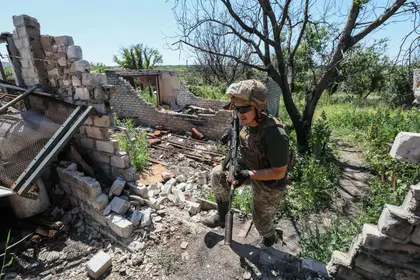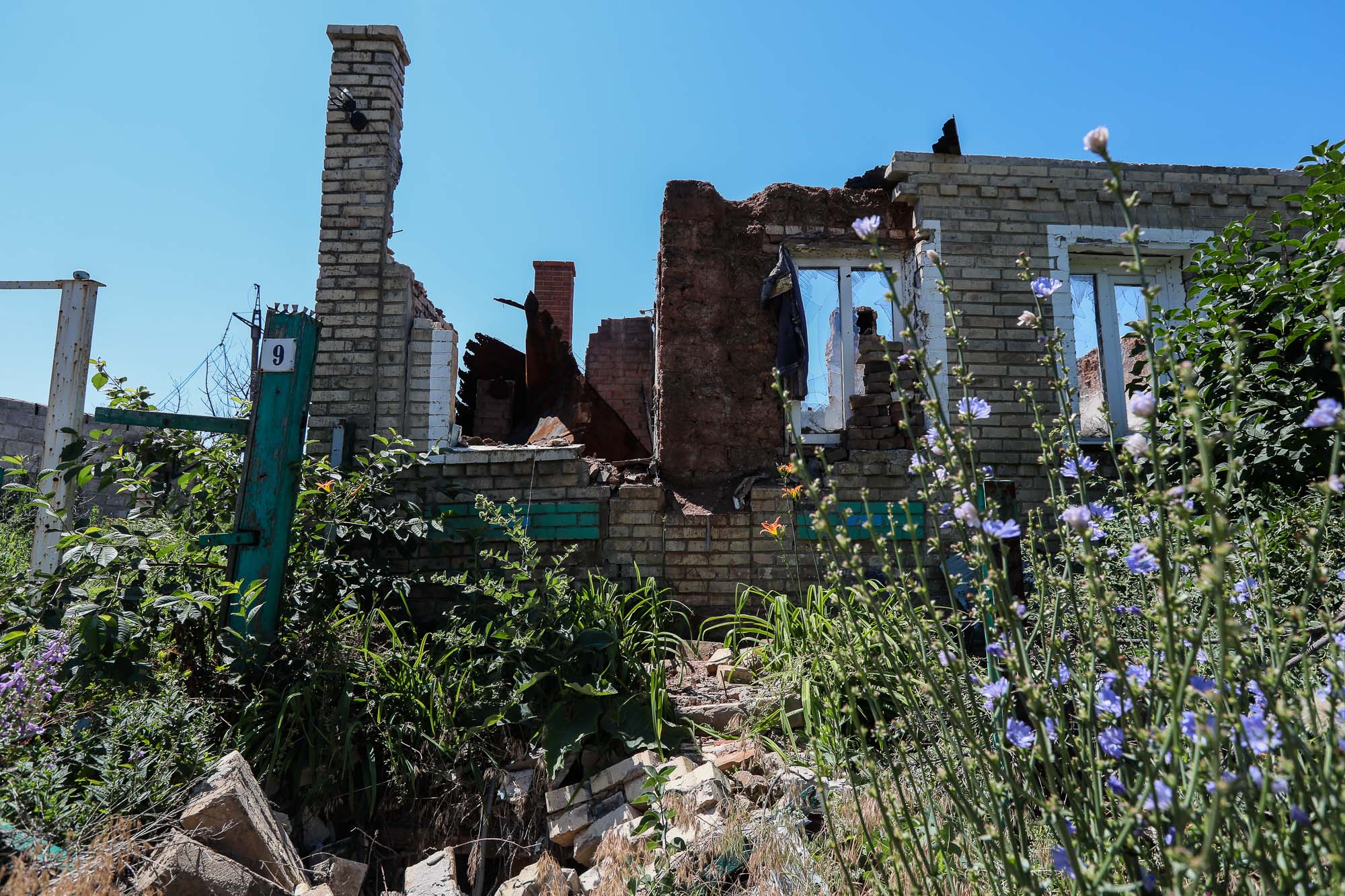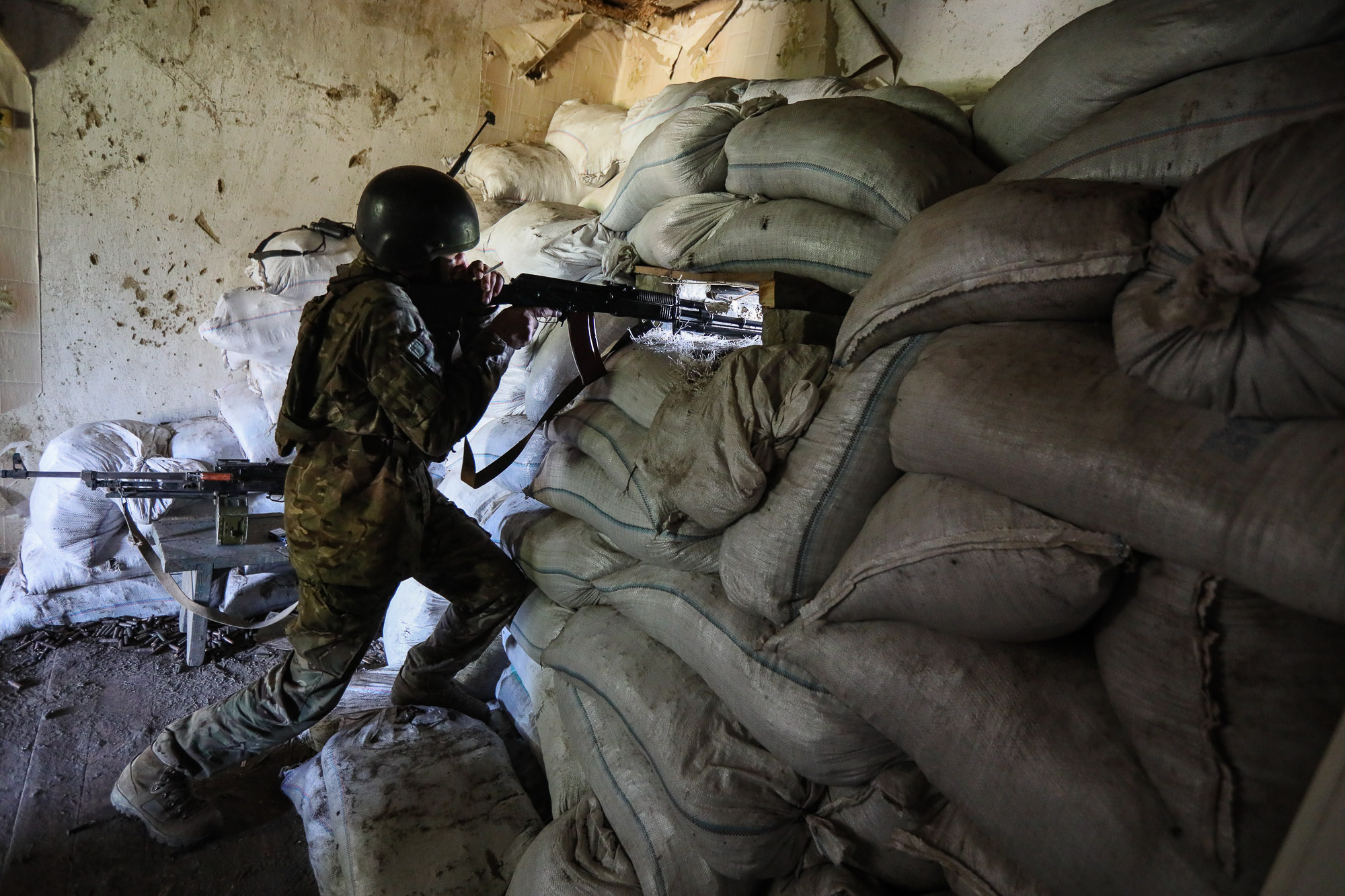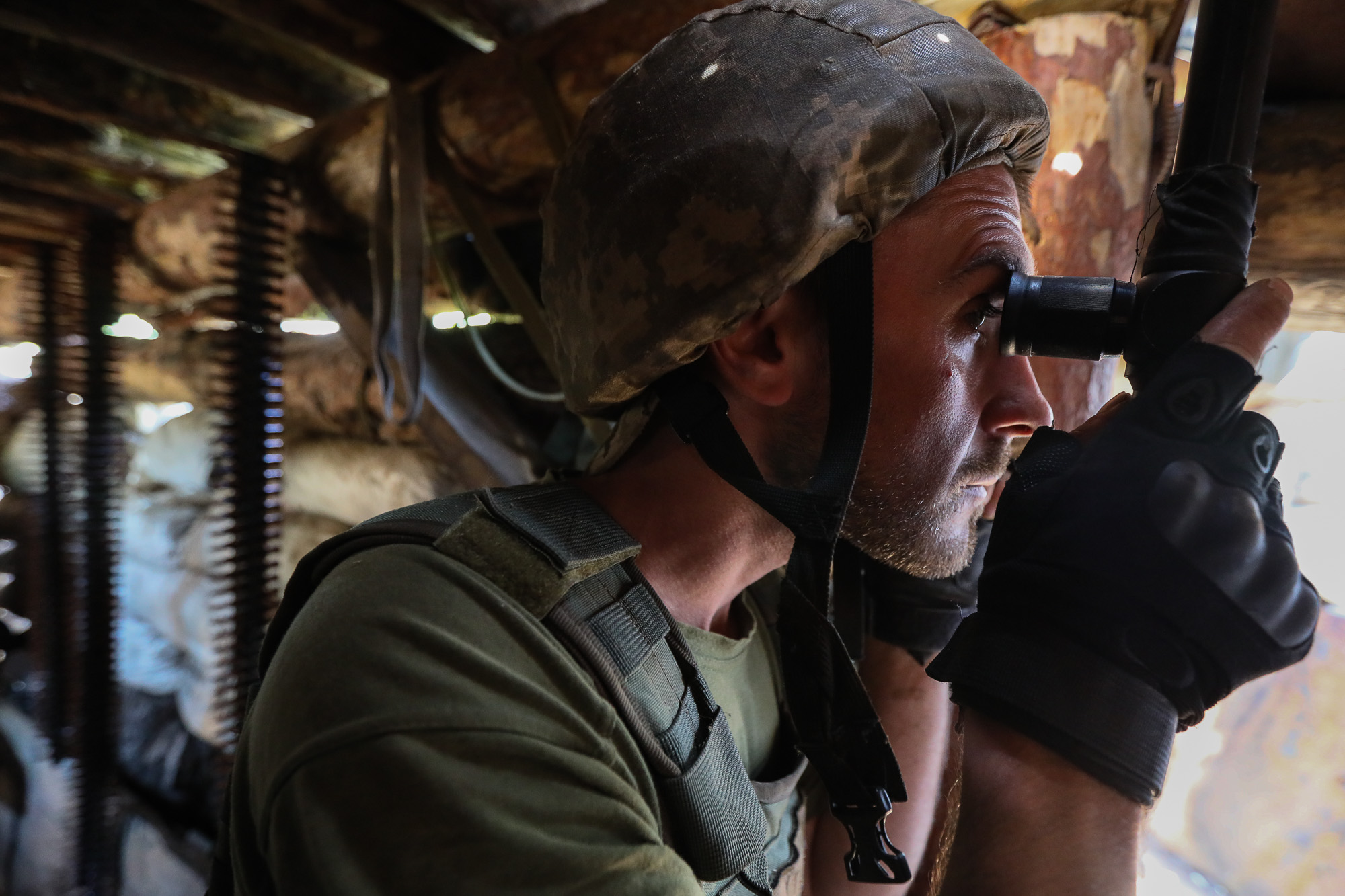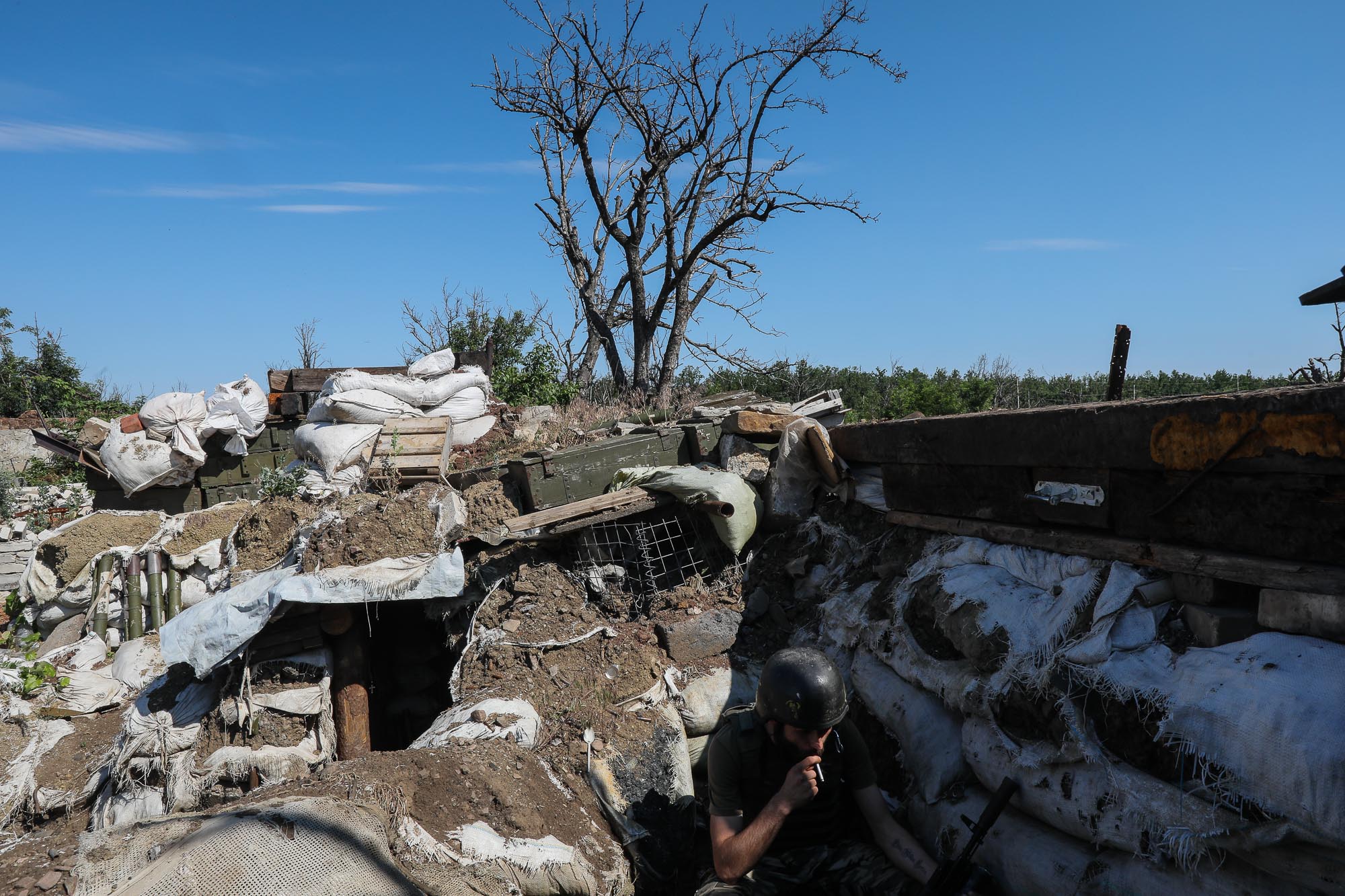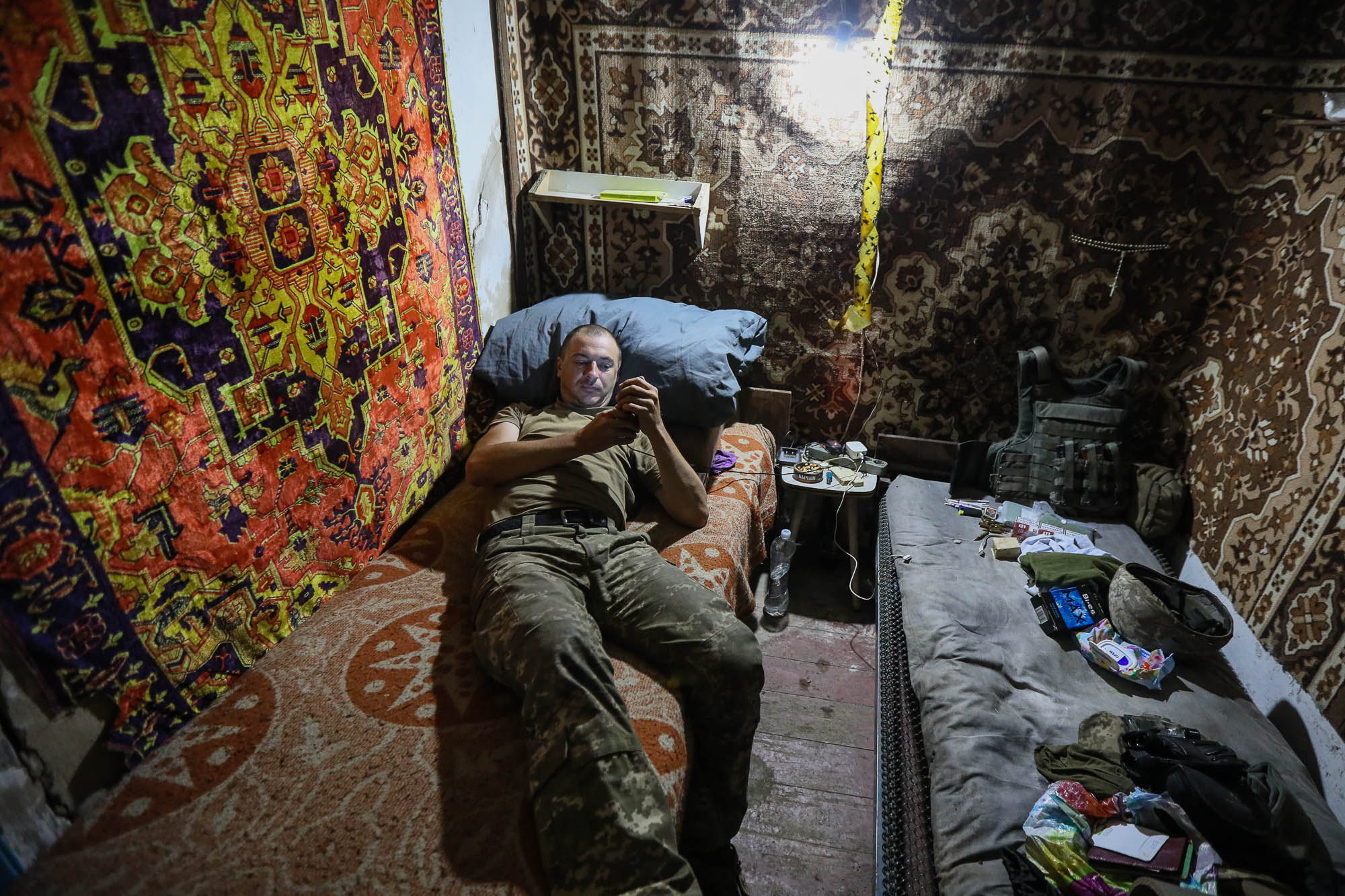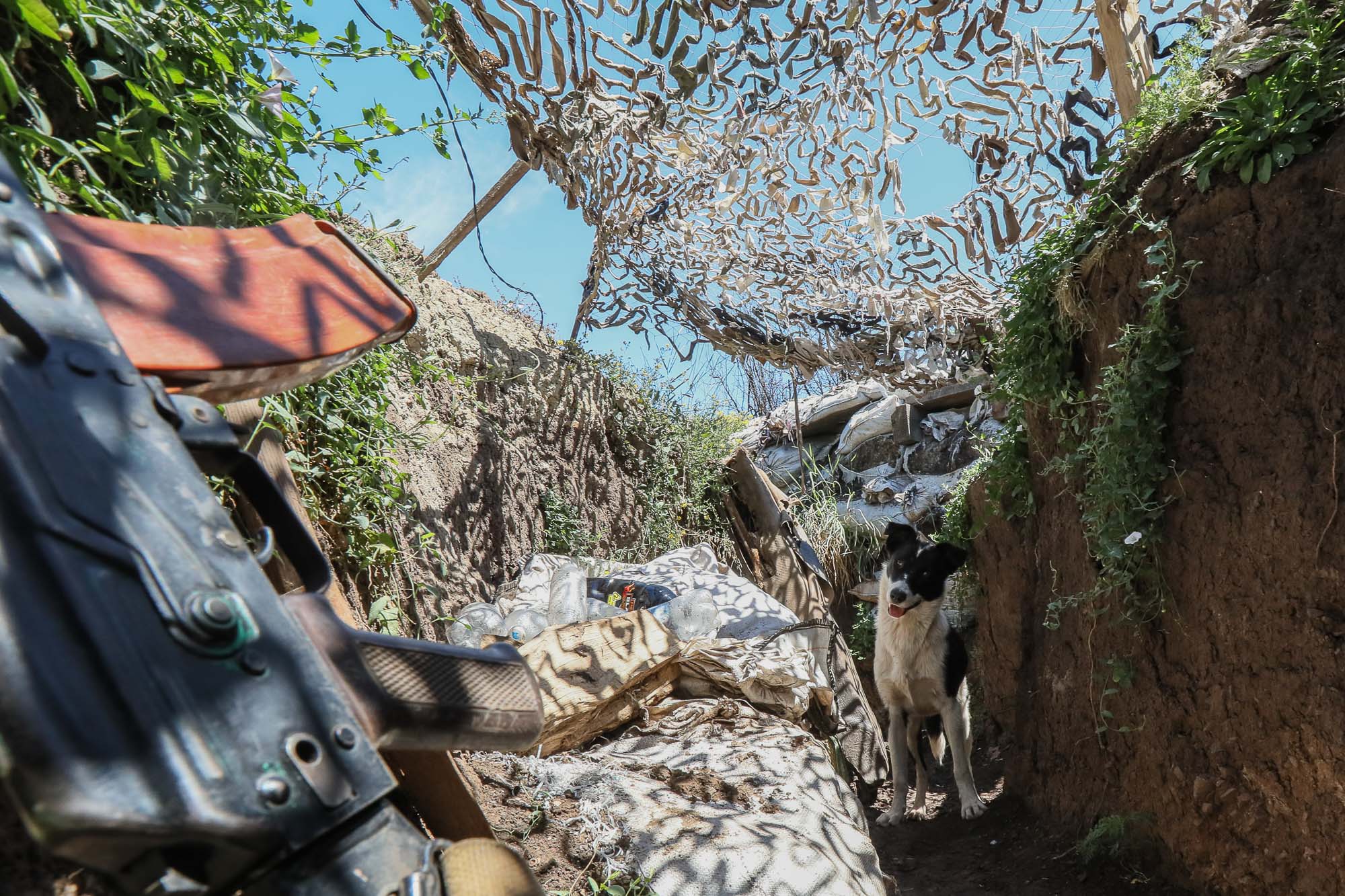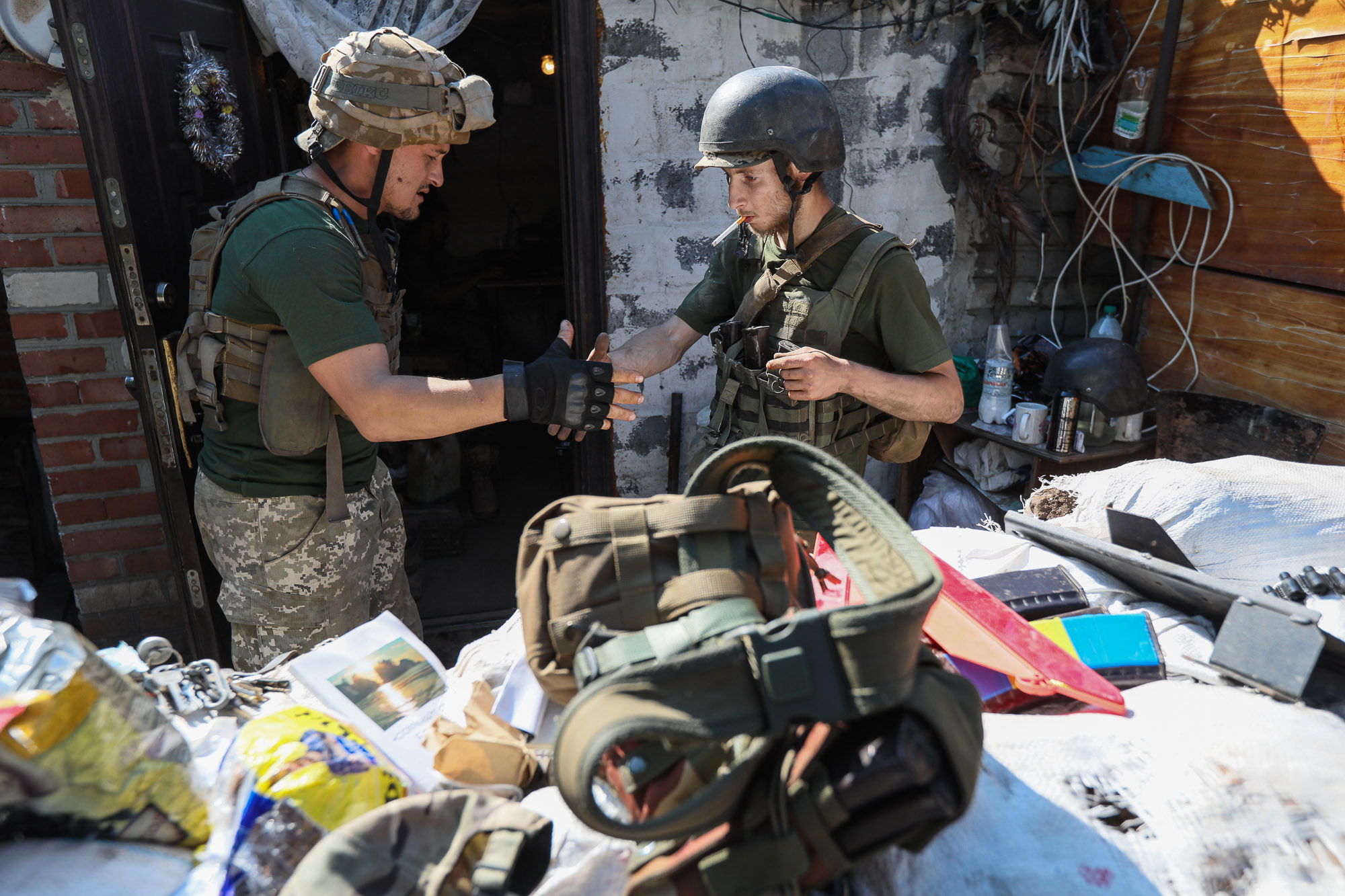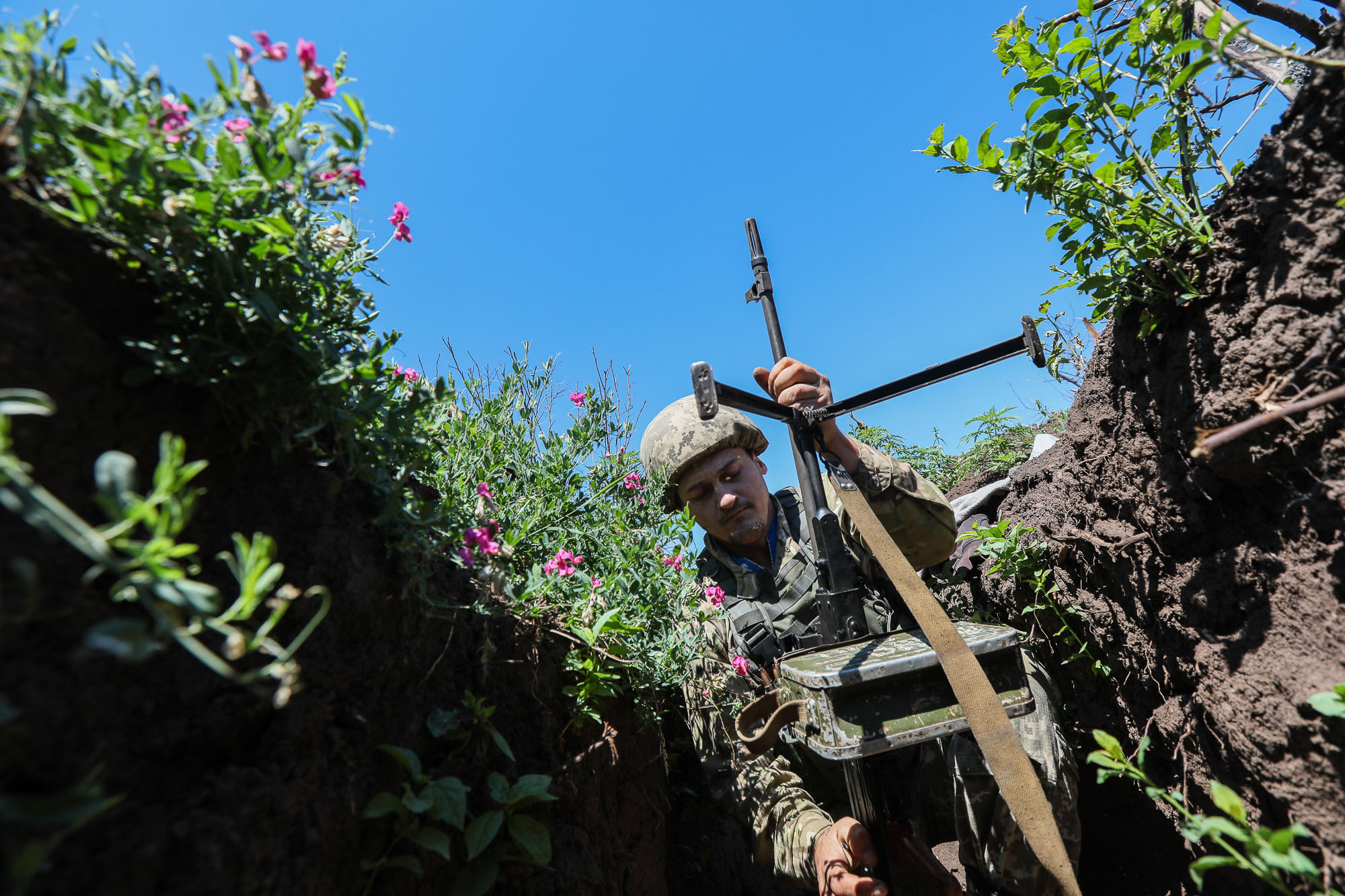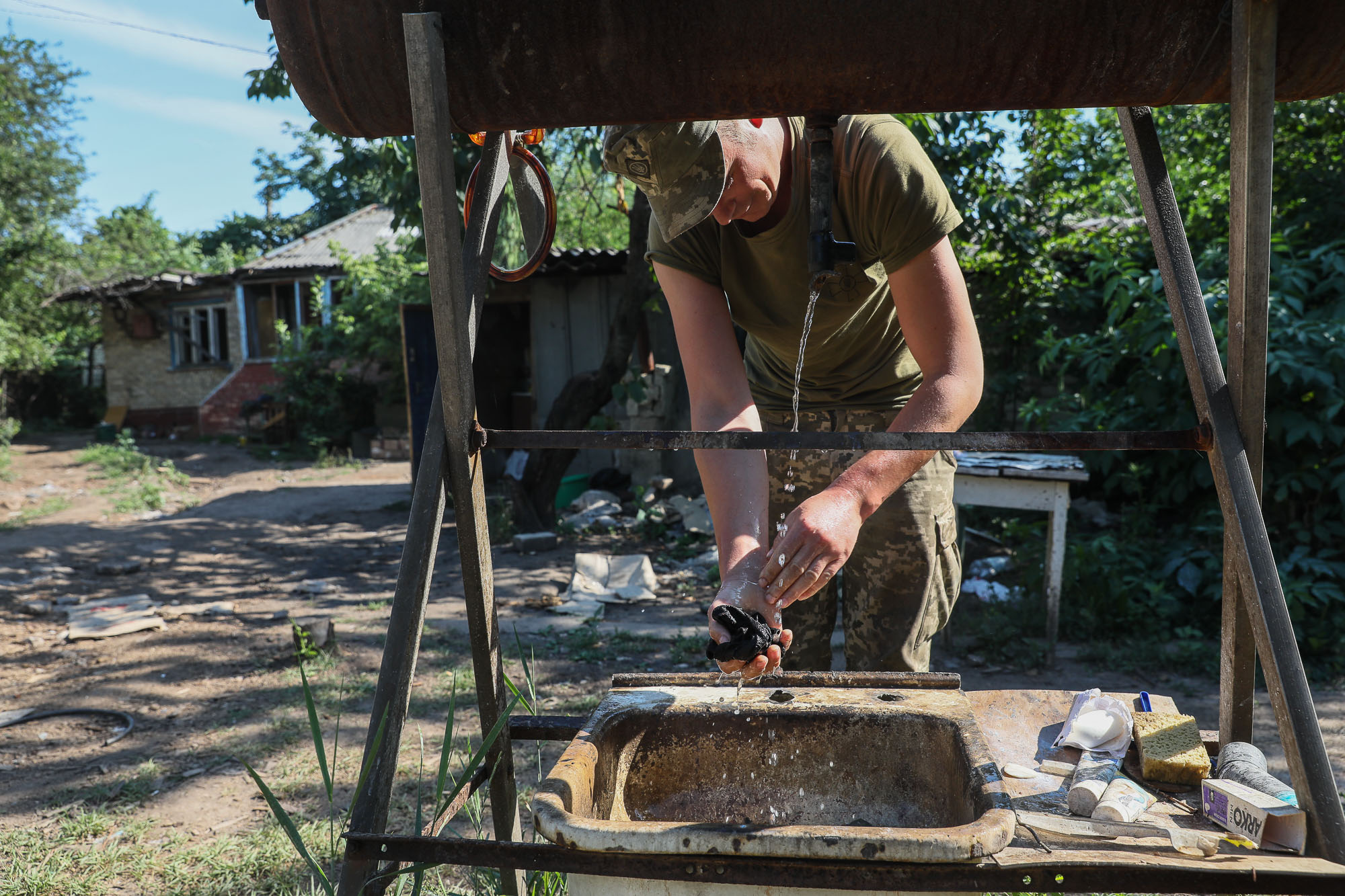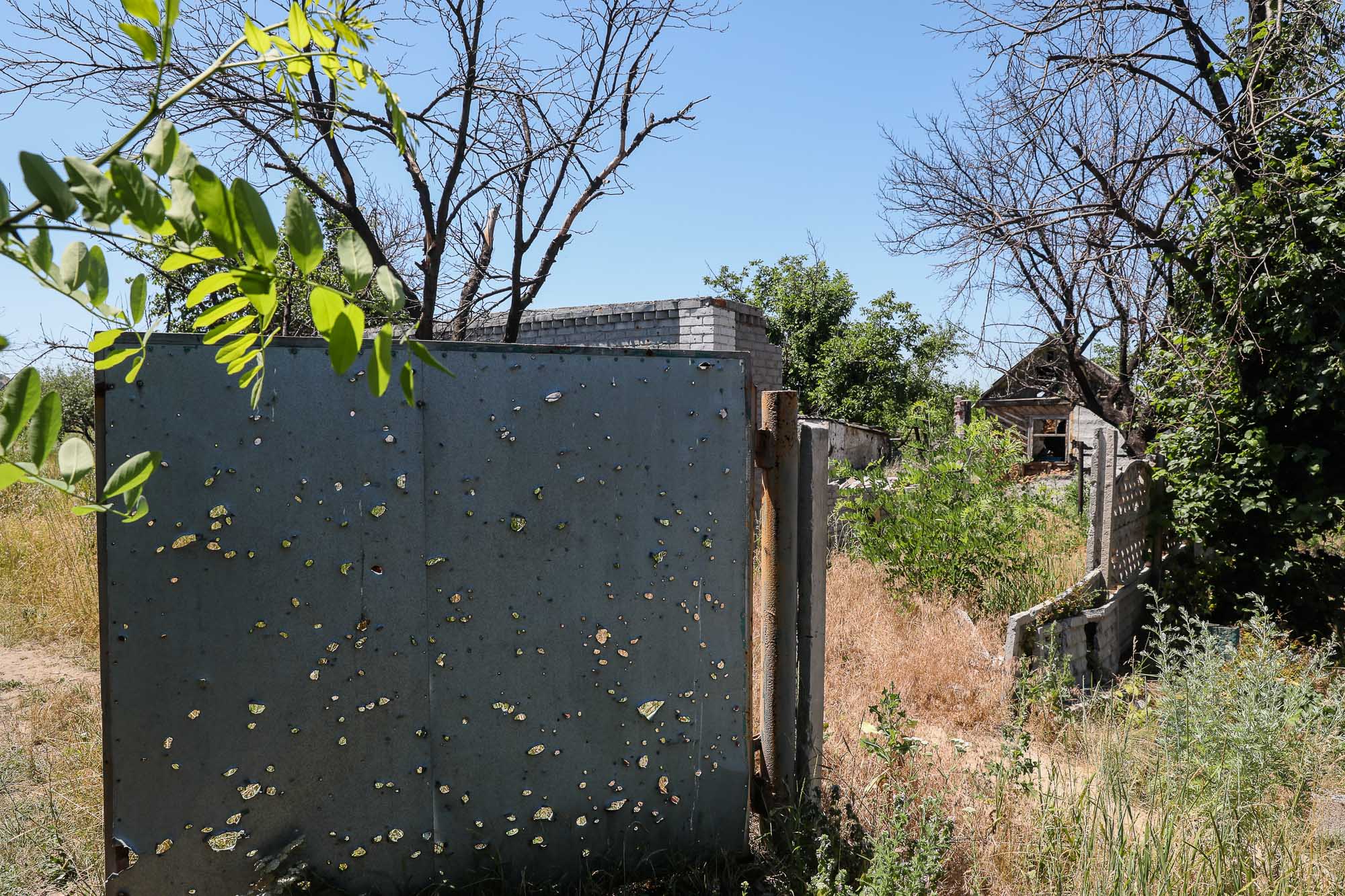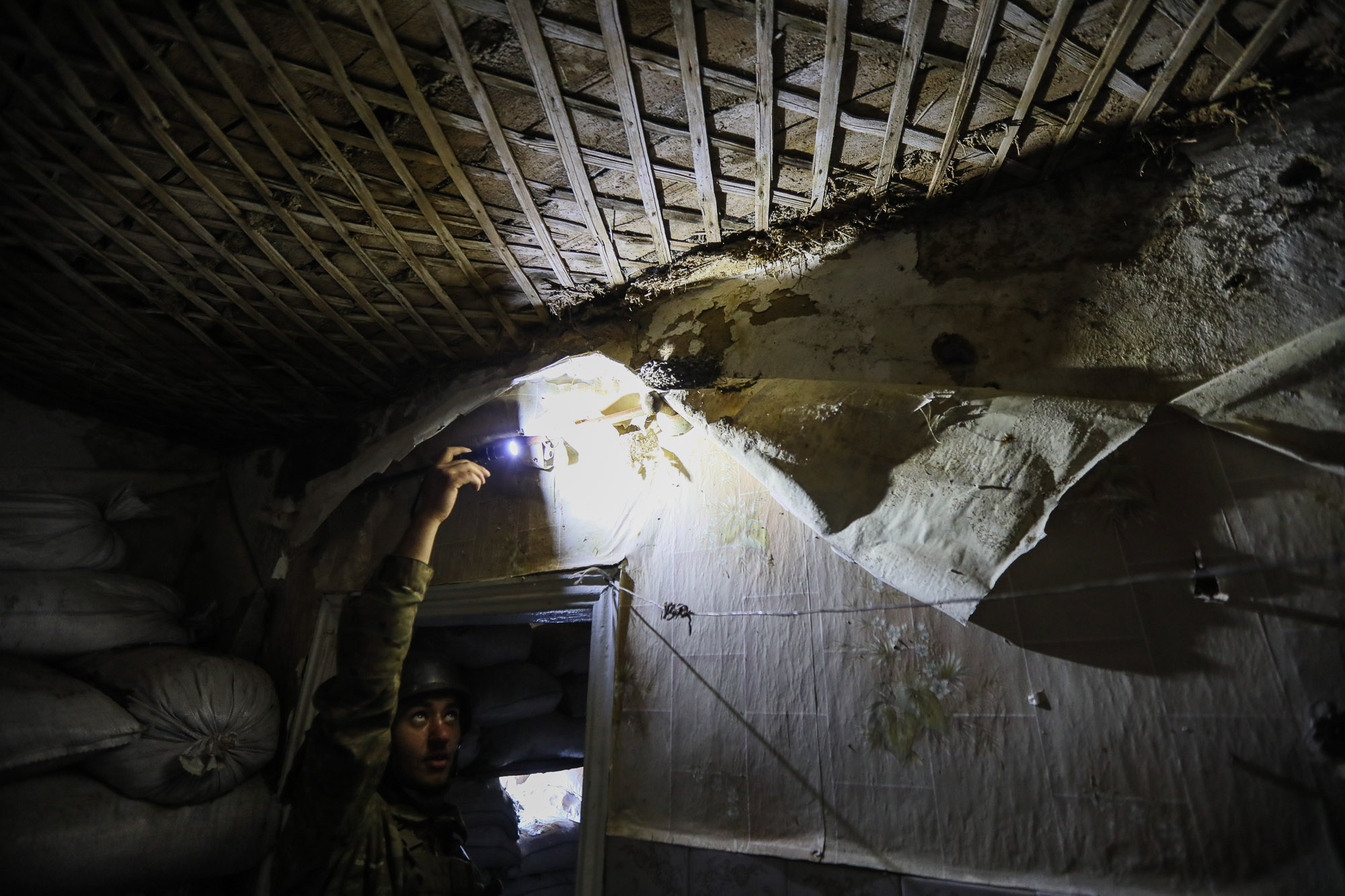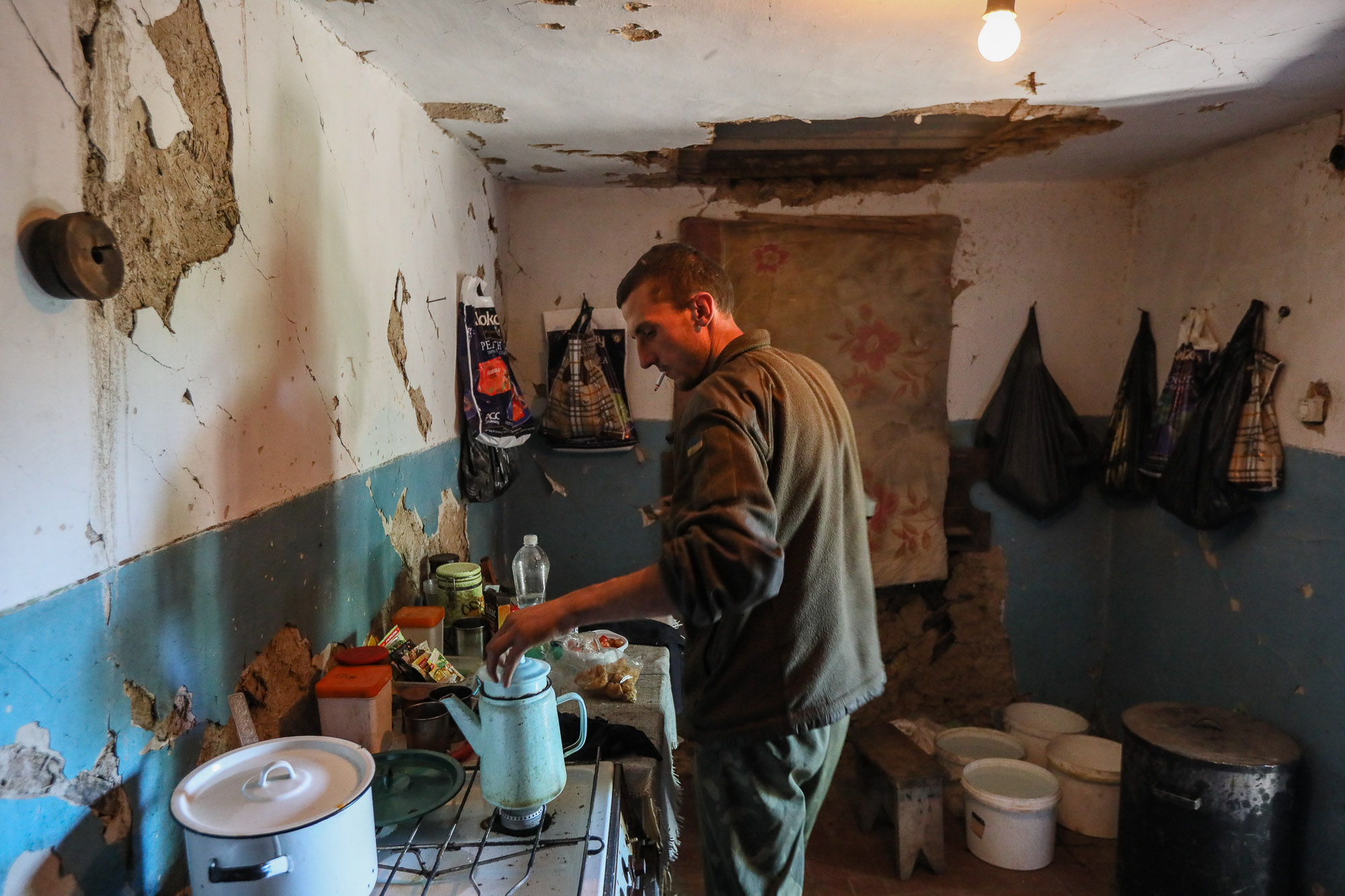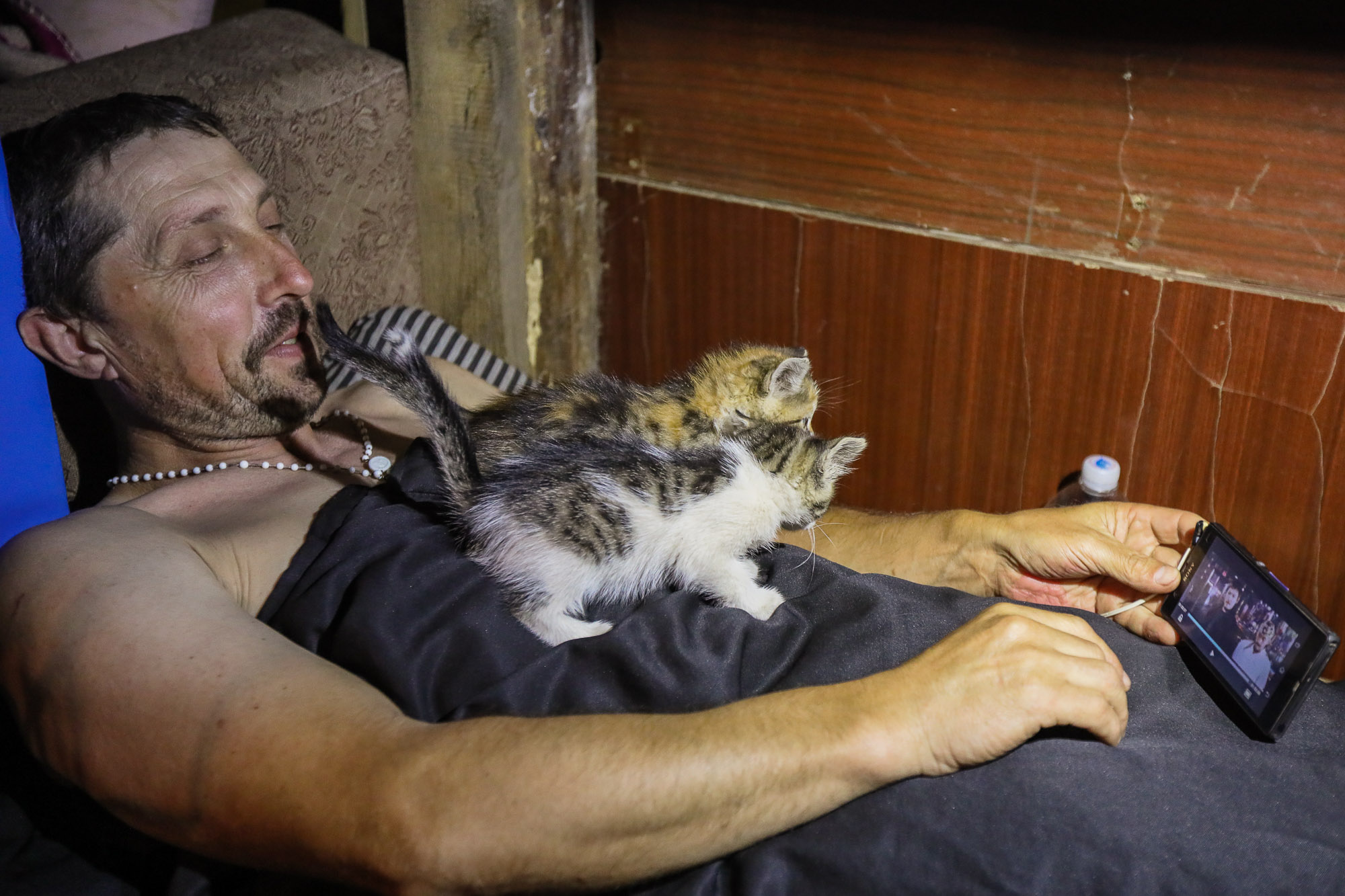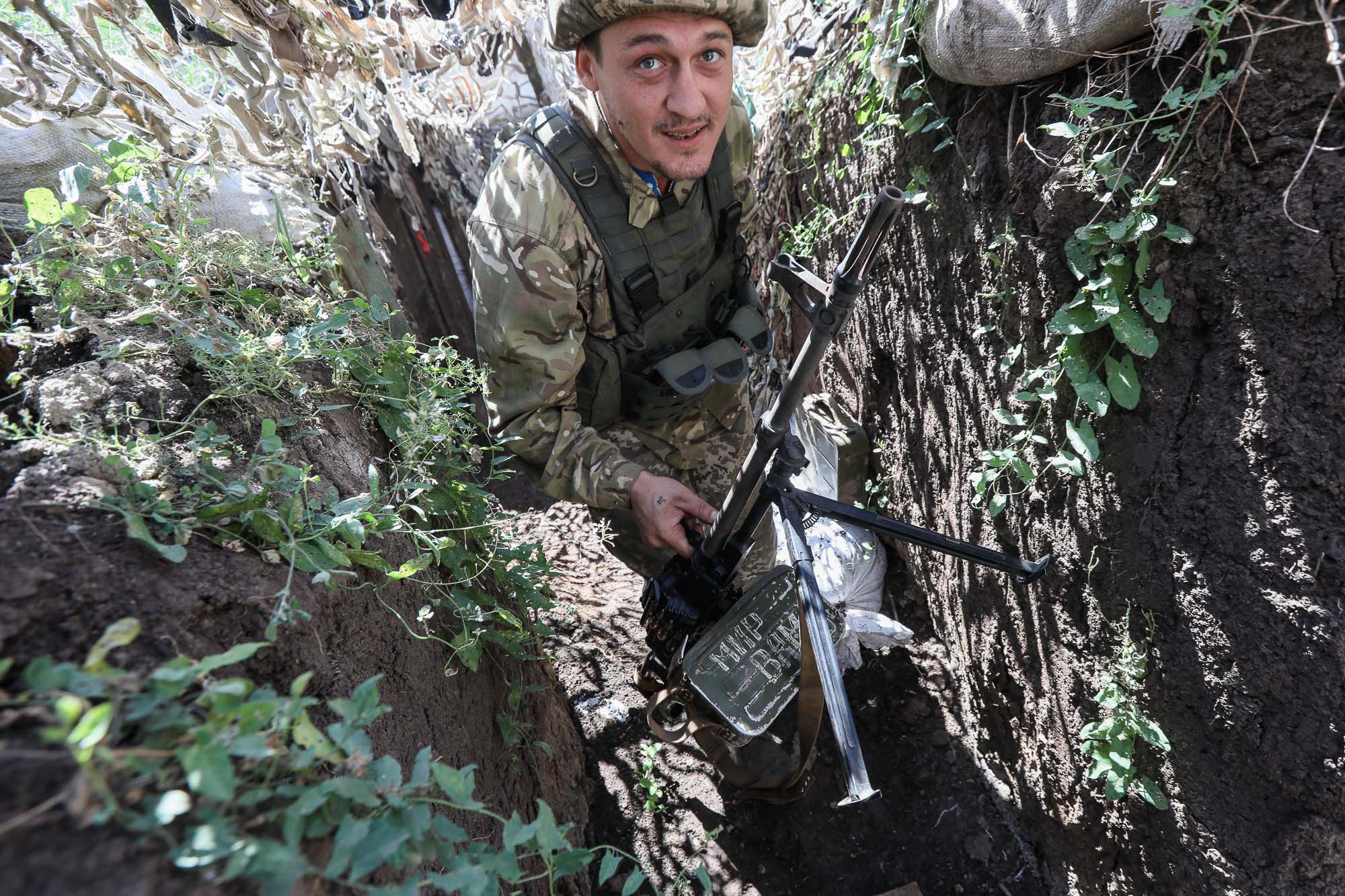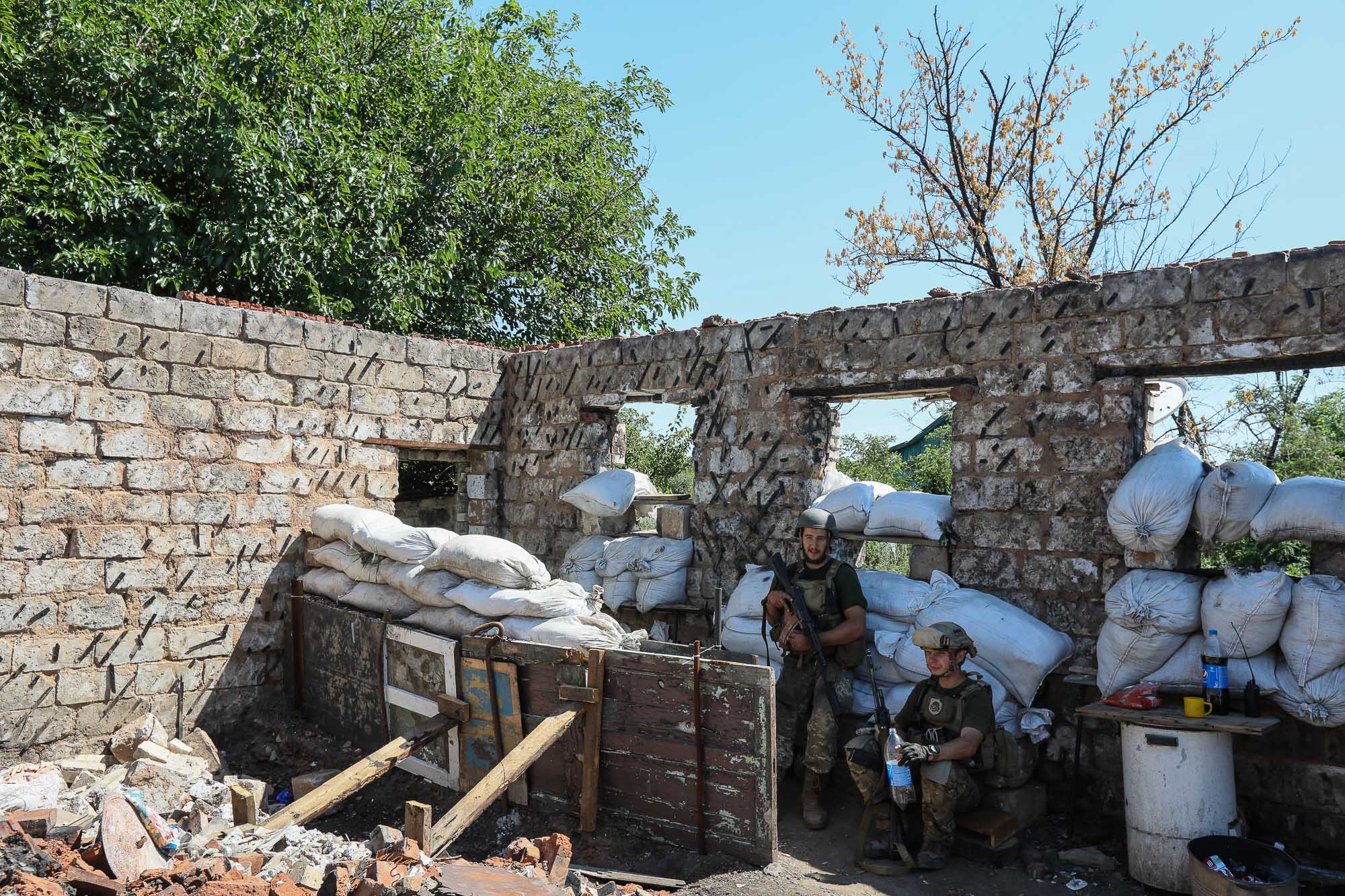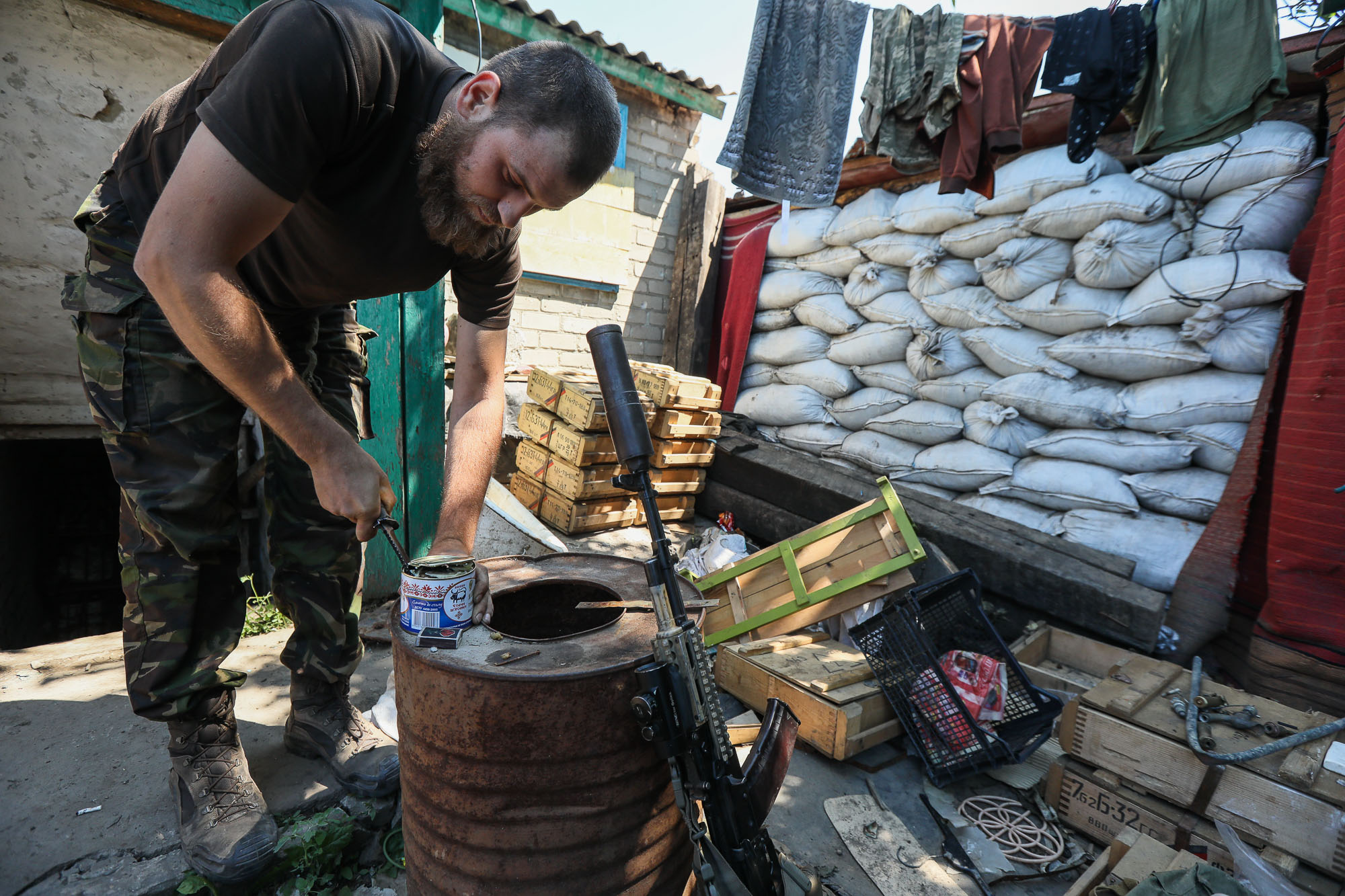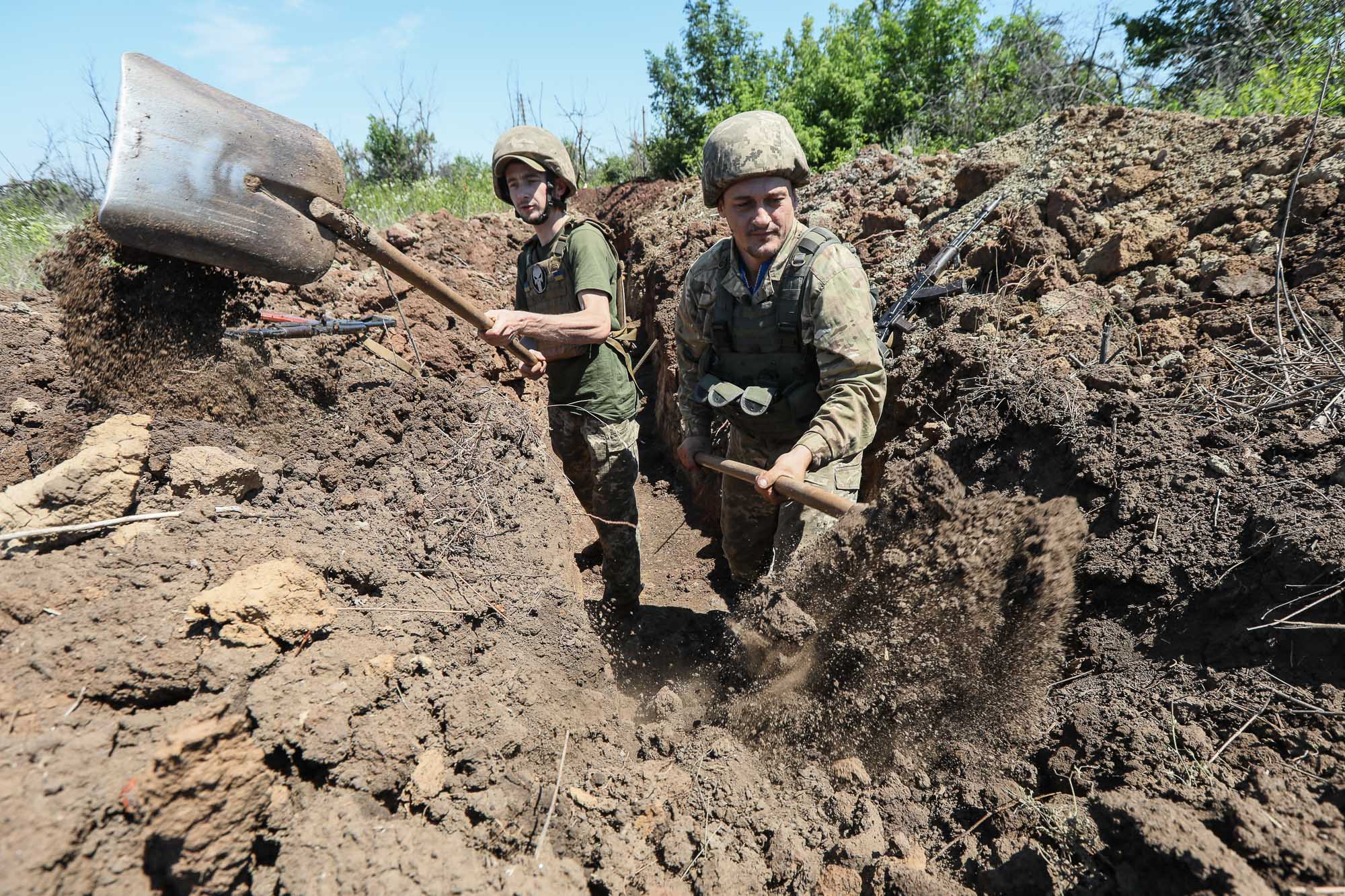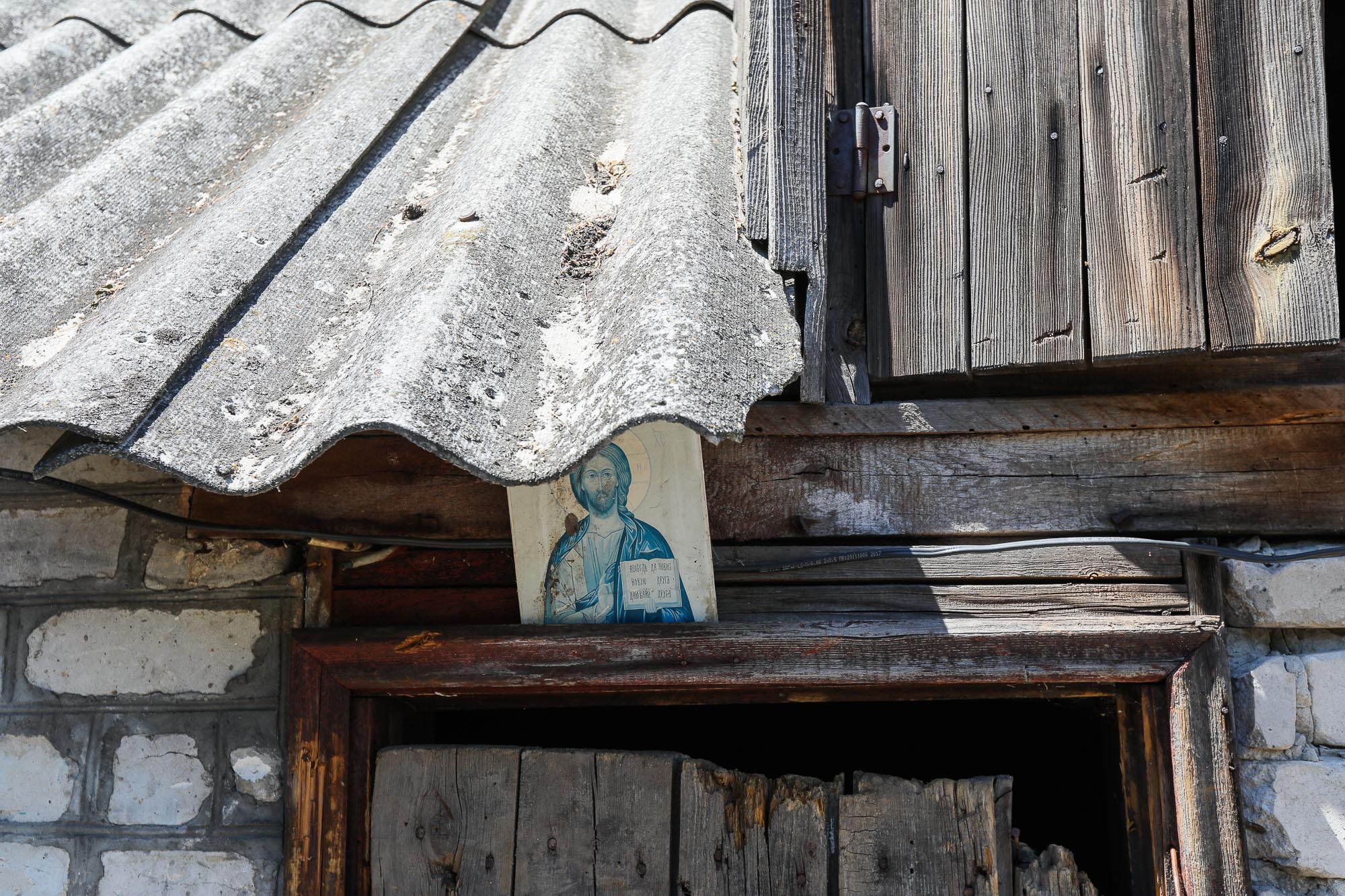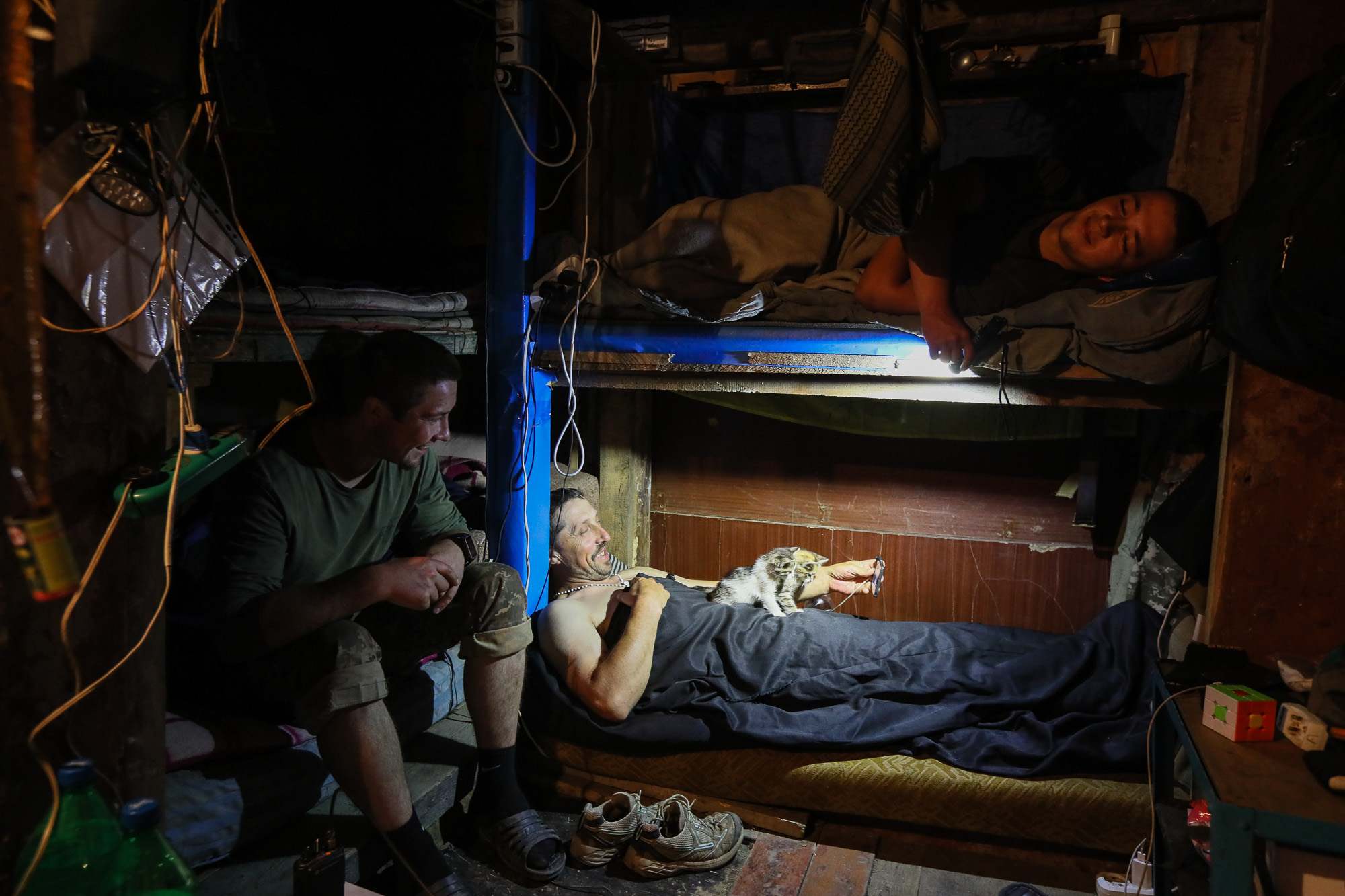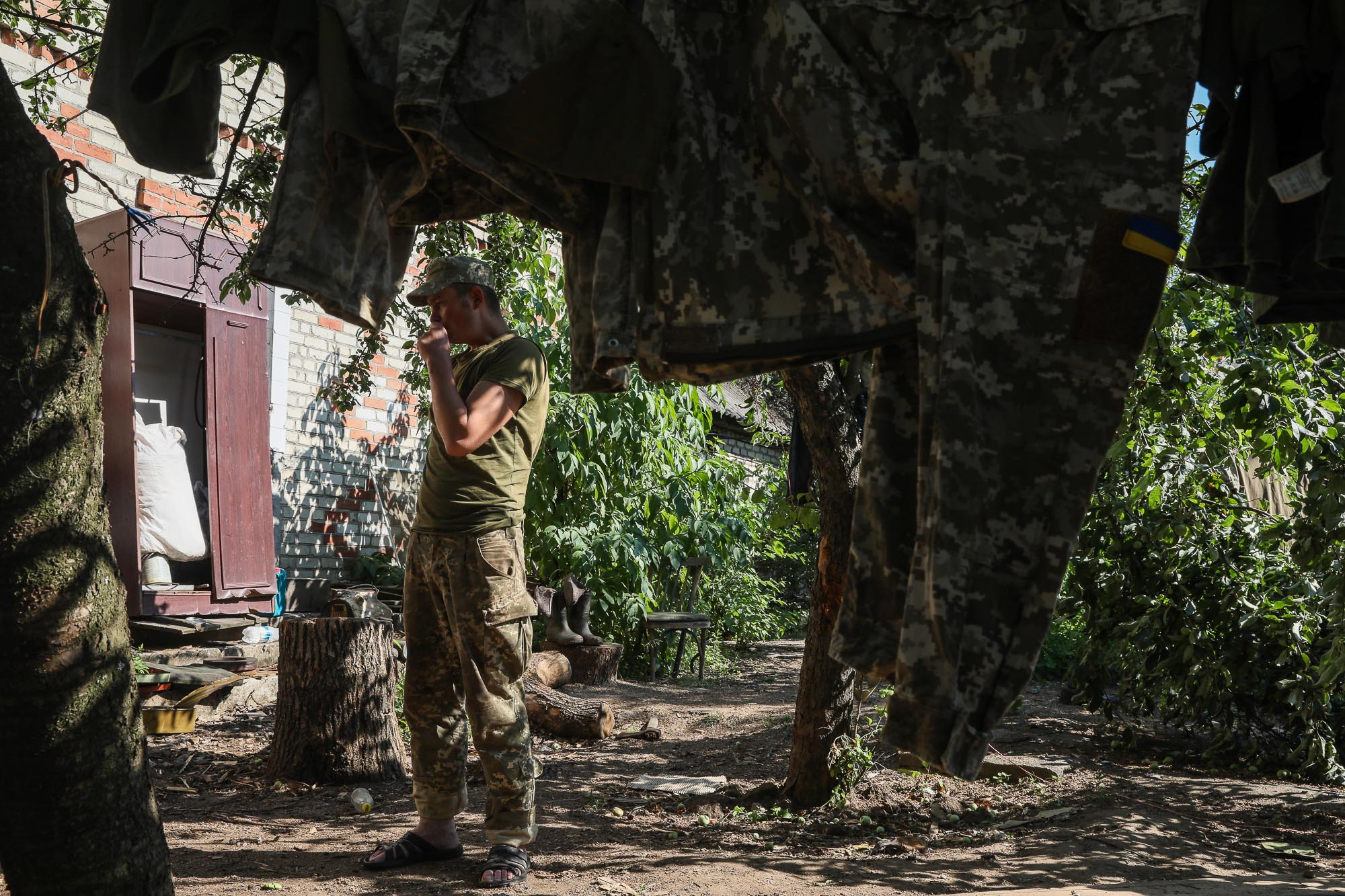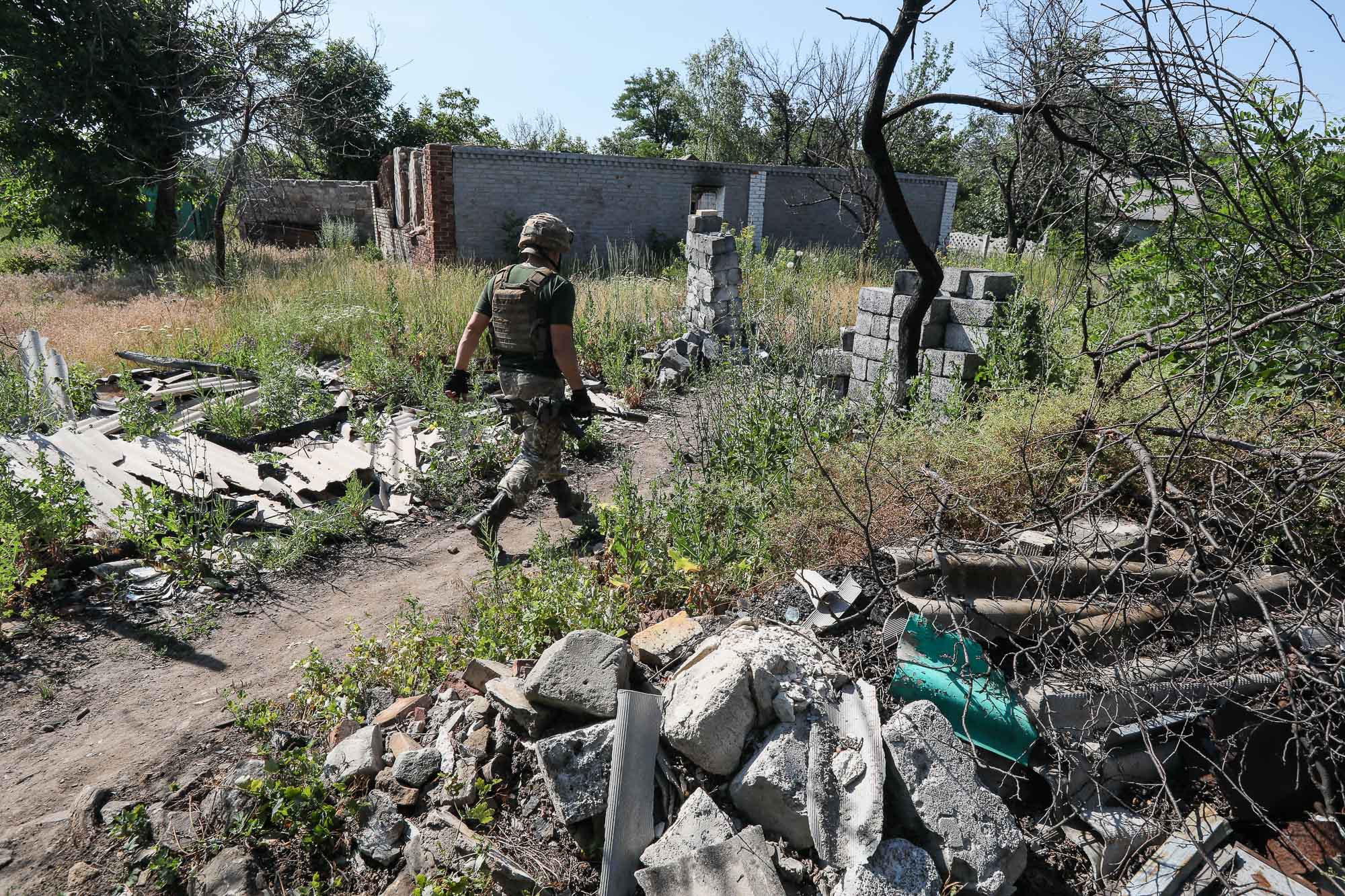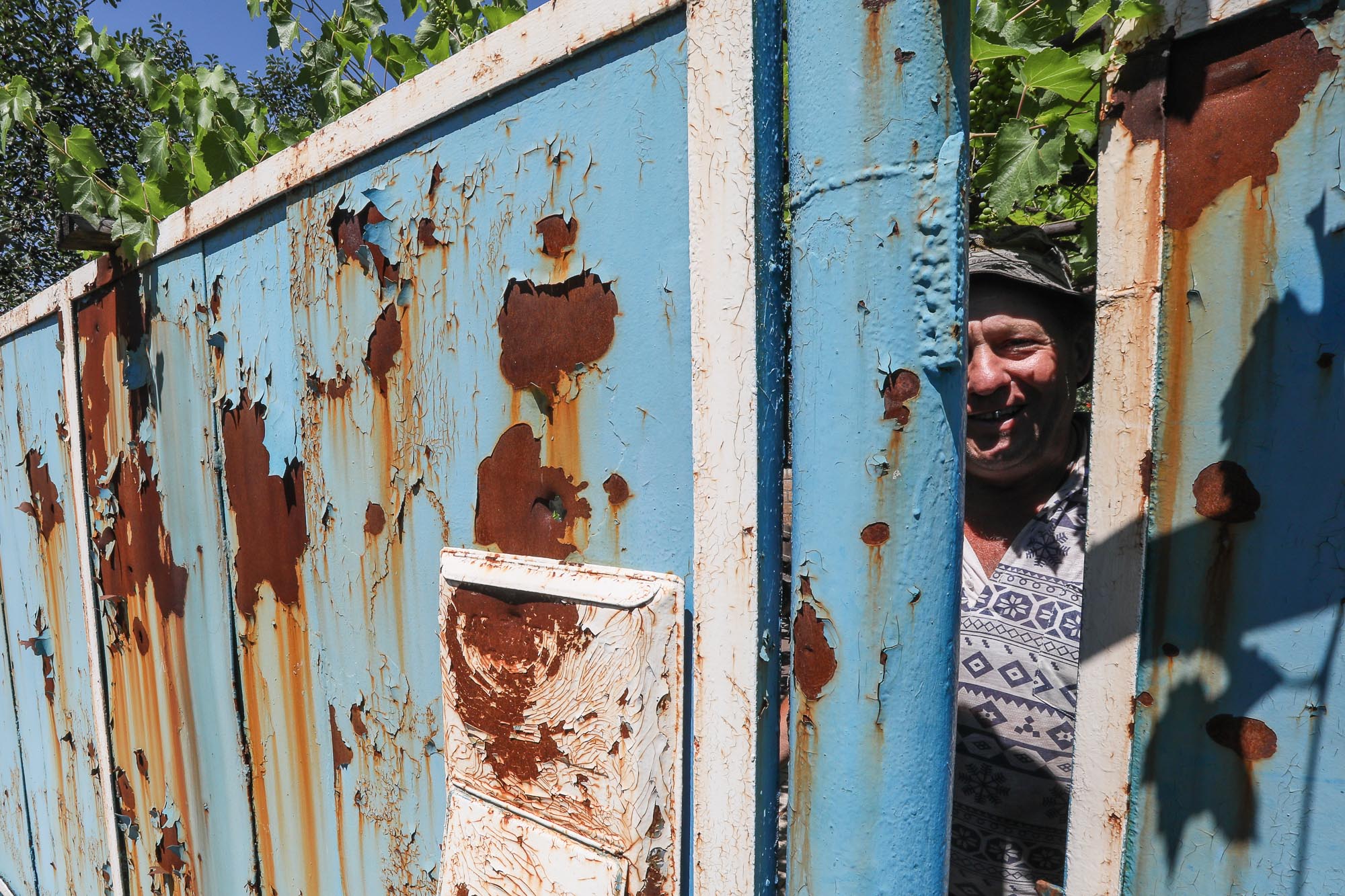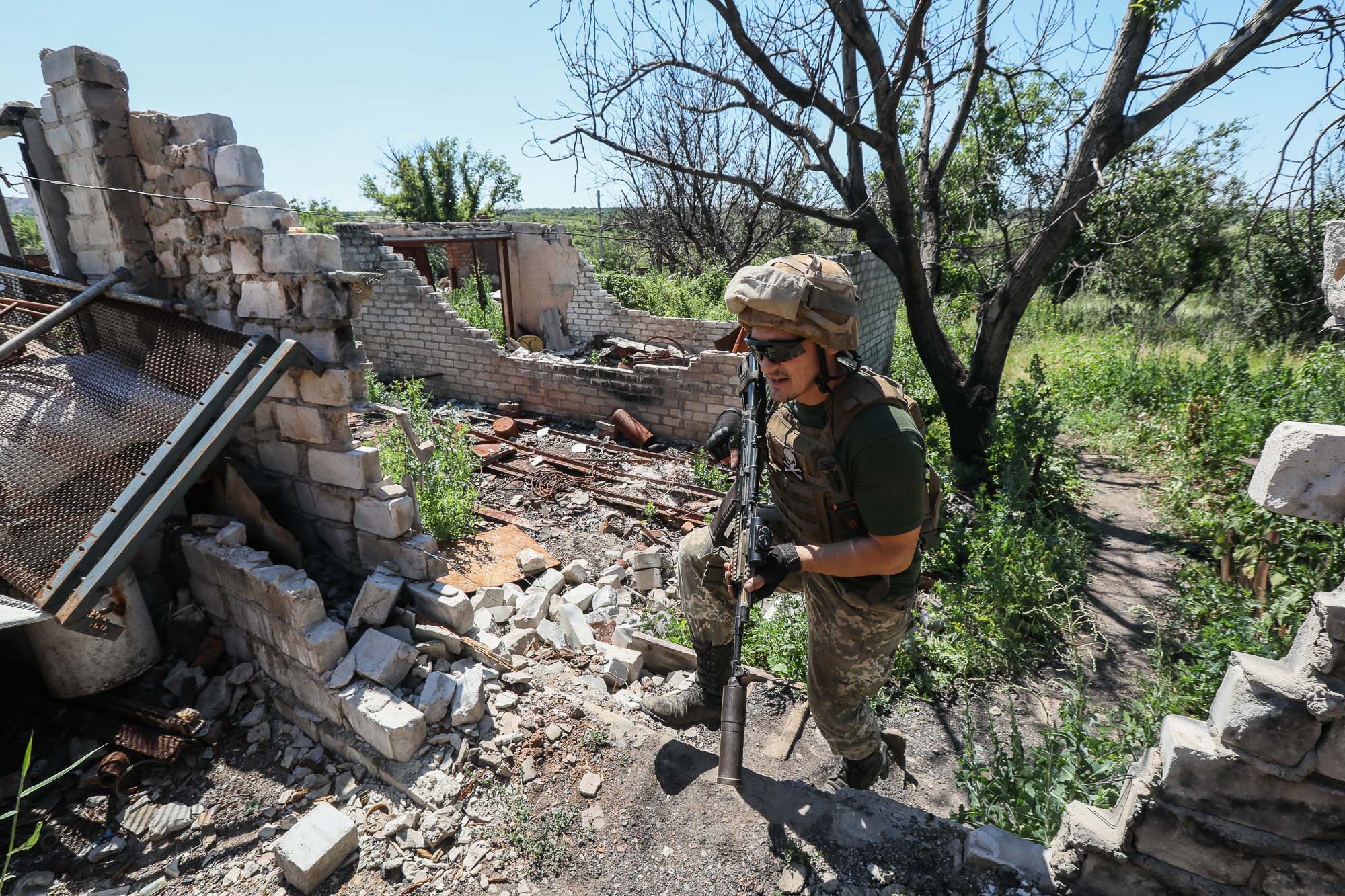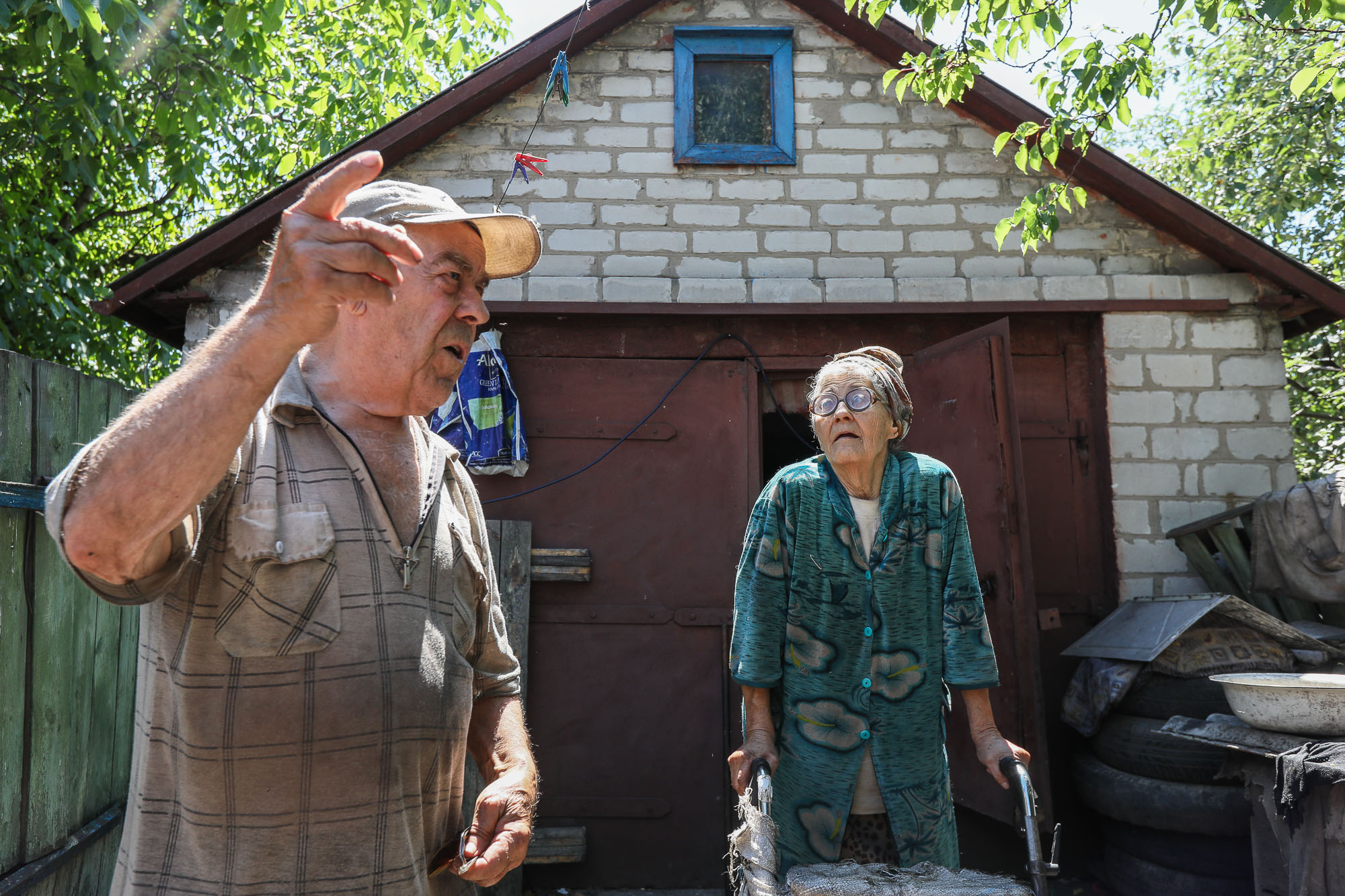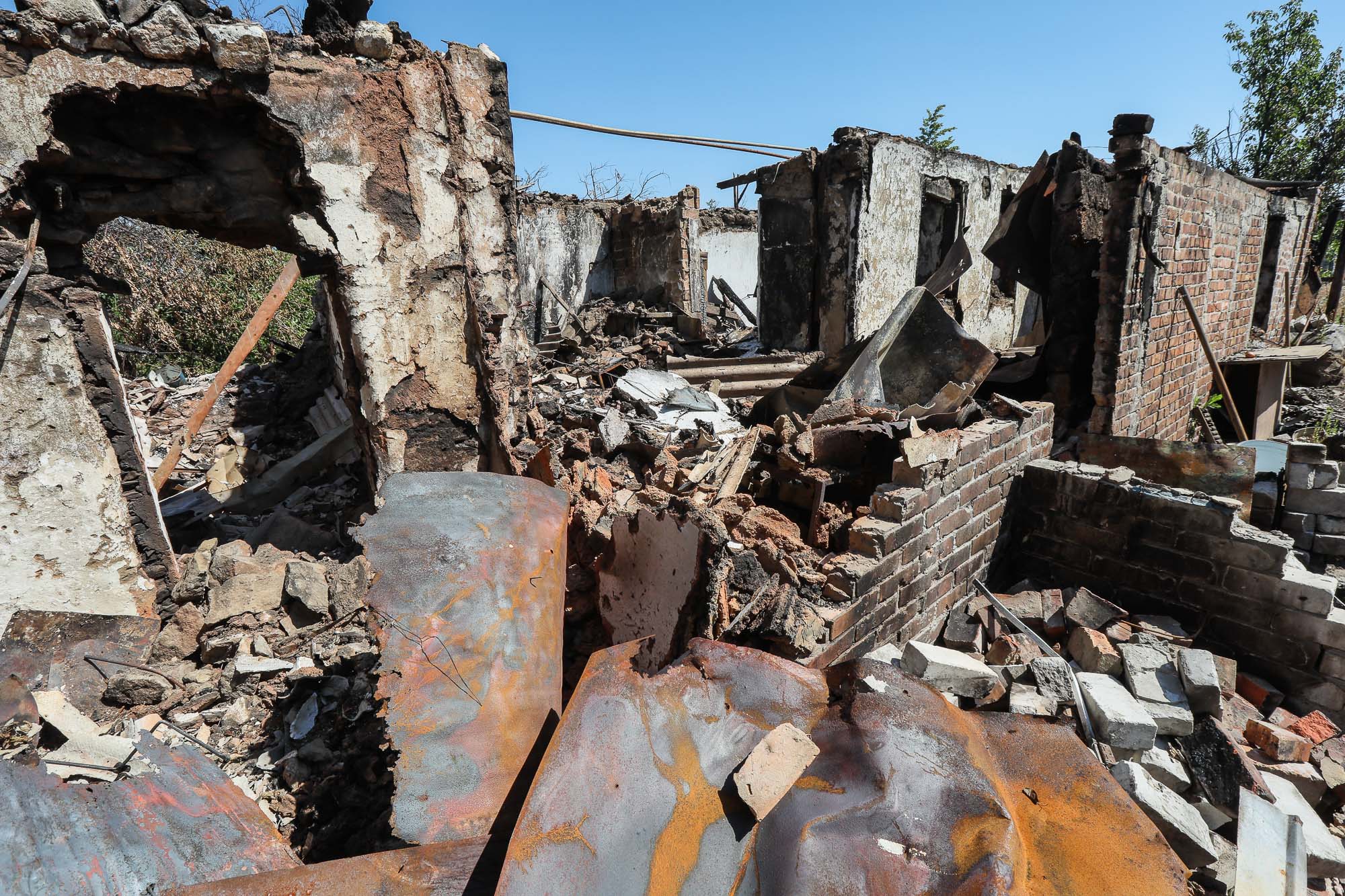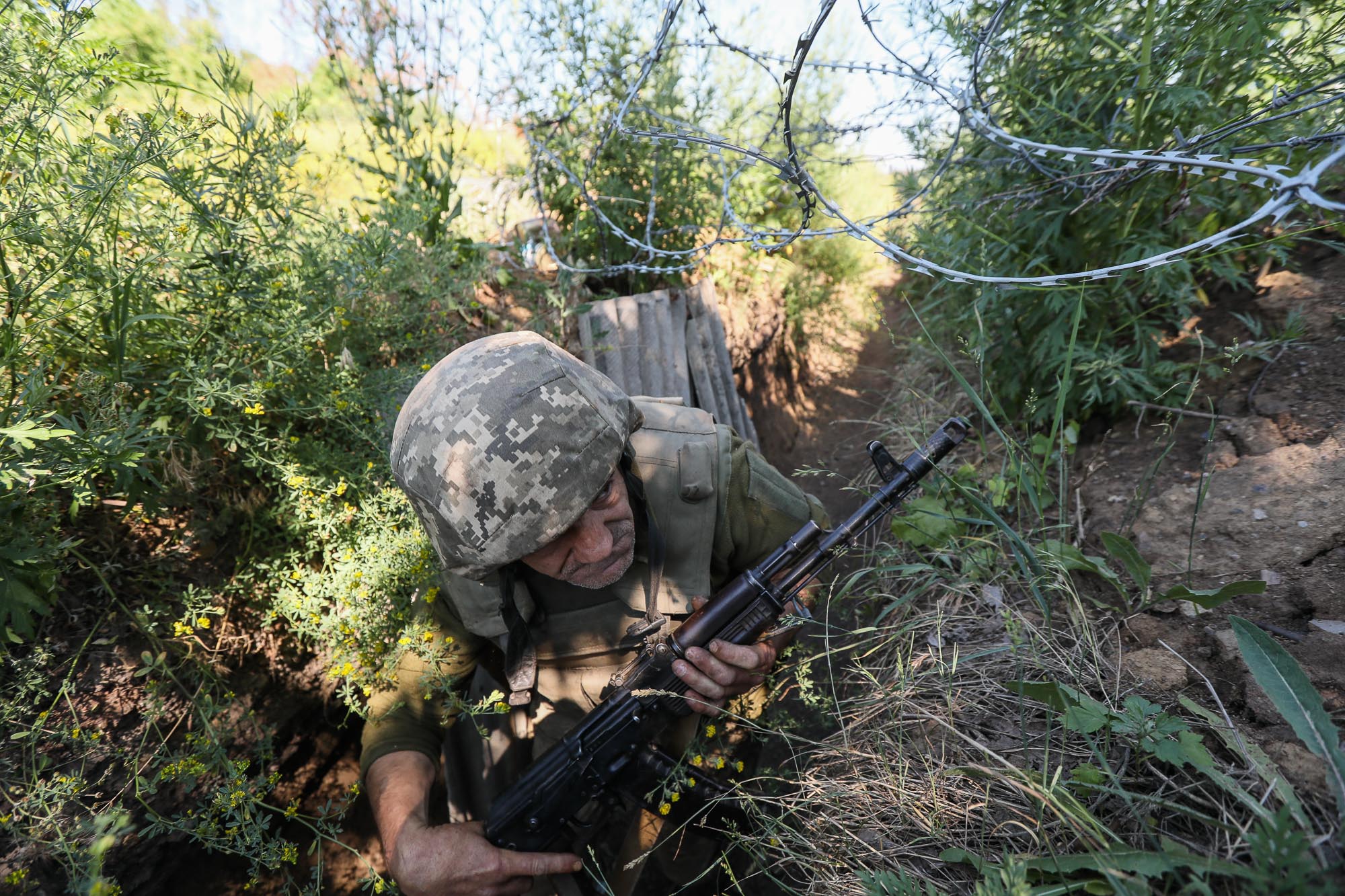ZAITSEVE, Ukraine — At noon on a recent hot summer day, a squad of Ukrainian infantrymen is sitting in a gloomy room behind a wall of sandbags.
Calm but alert, the soldiers smoke and sip energy drinks from plastic bottles, holding rifles in their hands and listening to the distant sounds of gunfire. It’s June 25. At any minute, the fighting could spread to their position, and they are ready to return fire at the enemy as soon as they are given the command.
JOIN US ON TELEGRAM
Follow our coverage of the war on the @Kyivpost_official.
Their fortified shelter was once the living room of a tiny old house in the quiet town of Zaitseve some 580 kilometers southeast of Kyiv, Before the war, Zaitseve had a population of around 3,400 people, and was effectively just a suburb of the Russian-occupied city of Horlivka. Today, barely 120 residents still live in the Ukrainian-held northern part of the town.
Now, it is a forward combat post in the very heart of the Donbas war zone, and it has been stubbornly defended by the Ukrainian troops for several years.
The chatter of machine-gun fire soon dies down, but the soldiers show little sign of relaxing.
“All right, don’t stand in front of the gunslots — snipers might be watching us right now,” says soldier Mykola Buzhara, an old warrior around 60 years old, as he gets to his feet, pushing himself upright using his aging AK assault rifle.
“And don’t speak too loud, the ‘separs’ (separatists) might freak out and start firing.”
The soldiers have every reason to be that cautious. Fighters from Kremlin-led forces are just some 30 meters away, manning their own fortified gun nests just across the street.
Here in this little town, less than 10 kilometers north of the Russian-occupied city of Horlivka, the combat line of Russia’s war in Donbas slashes straight through the scorched countryside cottages and backyard gardens. The enemy is less than shouting distance away.
Among the blackened ruins, the opposing troops clash almost every night in fierce house-to-house fighting and shelling duels that, though fierce, have brought no substantial changes to the shape of this battlefront for years.
Largely ruined and abandoned by most of its civilians, Zaitseve has been torn in half, with the Ukrainian army still defending its northern part, and Russian-led forces in control of the south.
The north is now defended by the Ukrainian army’s 24th Mechanized Brigade.
‘Let them try’
The first line of defense for Ukrainian forces stretches along Smolenska Street, which runs east to west through the center of Zaitseve.
A typical quiet village lane before the war, this street has been turned into a heavily fortified network of trenches, dugouts and machine gun nests, bristling with hundreds of meters of barbed wire. In the no-man’s land in front of the Ukrainian defenses there is a large patch of dead trees, stripped of their leaves by the shockwaves from shelling.
The main enemy lines are hidden behind some dense tree cover, but through binoculars, stealthy, shadowy figures can been seen in enemy forward positions right across the street.
“It looks like they’re building up really hard,” says Ukrainian soldier Serhiy Synenykov as he scans enemy lines through a surveillance periscope from an underground observation point.
He points out to a newly built wall of white sandbags beside a dugout that can just be made out behind a cover of vegetation.
“I dare them,” says Artem Zabskiy another of the young soldiers manning the combat post. He calmly loads 7.62-millimeter cartridges into his rifle’s magazine.
“Let them try and show off — we have a nice story to tell,” he smiles, nodding at the tube-like Shmel rocket launchers with incendiary rounds leaning against the wooden walls of the dugout.
In such static, close-combat warfare, any attempt by the enemy to creep forward, even by a few meters, cannot be left without a response, but this fuels fresh fierce fighting.
Just behind the Ukrainian defenses, the deserted streets of Zaitseve are decaying and becoming overgrown with grass and bushes. In summertime, this thriving wild vegetation veils the silent gloominess of this dead town somewhat, obscuring the dismal view of ruined and burnt-out houses.
Many of the houses close to the current front line, tidy and well-kept before the war, have been reduced to shattered walls by regular mortar and artillery shelling, their stone chimneys the only parts of their interiors not completely leveled by fire.
“Incoming strikes detonate here almost every day,” says another young Ukrainian soldier, Yuriy Chernyavskiy, as he walks over a heap of crushed glass near a destroyed garage. The broken glass crunches loud under his boots.
“So watch your step — you never know where an unexploded shell might be waiting.”
As the soldiers slowly walk among the ruins, their rifles cradled against their chests, the sounds of gunfire, blasts and booms can be heard time and again in the distance: the fighting all along the 400-kilometer frontline in the Donbas never stops completely.
Lost and forgotten
But Zaitseve is not as deserted as it appears to be at first glance. People still live in some of the more-or-less intact houses away from the front line.
Here and there, from behind old and rusty metal gates riddled with shrapnel holes, the faces of last local civilians appear when the soldiers call.
Among them are Mykola and Tamara Vdovychenko, a couple both in their late 70s.
Like many thousands of lonely elderly people trapped in the Donbas war zone, they have nowhere else to go and no choice but to live just a few hundred meters away from the front line.
“When the shelling starts, we hide underneath our garage,” Mykola says in a trembling voice as he points to a stair descending into a cold concrete cellar. He doesn’t even look at it.
“We’re really old, and for us, every time we go downstairs there, it’s just torture.”
His wife Tamara is extremely frail, and can move only by leaning on a makeshift walking frame. Nonetheless, she smiles and seems happy to speak about their life – not many people express interest in the elderly couple, lost and forgotten in this war zone.
“By the way, a couple of days ago, some bomb boomed in our backyard garden again,” she says.
“It killed several of our hens and smashed our fence. My husband says it was an 82-millimeter mortar shell. Thank God the soldiers came soon to check the impact hole and quickly repaired our old fence.”
“I sometimes like to joke about my life,” she continues. “I was born in the time of (World War II), and now it seems like I will die during another war.”
The couple live in extreme poverty, and the clothes they wear are dirty and threadbare. Even though they receive their pensions, they rarely have the chance to get hold of cash — to do that, they have to arrange for someone in the military, or a neighbor, to take their bank cards out of the combat zone to withdraw cash at the nearest ATM.
They barely have the strength to move beyond their own yard.
“My wife needs constant care — she won’t survive without me,” says Mykola after Tamara walks away slowly to rest in the house. “But on top of that, I’ve got my own problem.”
He removes his big black sunglasses. One of his pupils is a pale, milky white — he has a cataract.
“I’m almost blind. I can’t see anything except flashes of sunlight and shadowy shapes of people and large objects around me.”
In the further course of the conversation, after a couple of attempts to evade the question, Mykola admits that in 1987 he served as a technical specialist with the Soviet KGB in Afghanistan.
Since then, he and his wife had been living a quiet life in Zaitseve — until the Kremlin found him again with its latest war, three decades later.
“I was in the military, just like those young soldier boys whose voices I sometimes hear near our yard gates,” he says with a sigh. “To be honest, I feel sorry that they have to spend their best days in this damned war, unleashed by the old.”
“As a former military man, I clearly understand where all the mines and shells are coming from — they’re all fired from the south, where the separatists are.”
“And I keep asking myself: ‘What’s all this for? What are they fighting for? More territory for (Russian President Vladimir) Putin?’”
“Doesn’t Putin have enough land in his Russia?”
You can also highlight the text and press Ctrl + Enter


